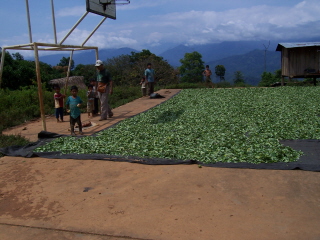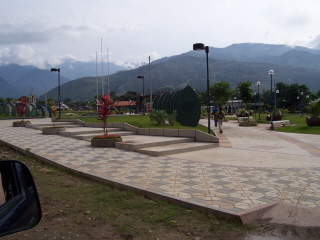On the eastern side of the Andes, where from their heights, the mountains drop down thousands of feet into the jungles (selva) of the Amazon basin, several hundred thousand Peruvian peasants are making a living -- but not much of one -- by growing coca. While the farmers and the coca leaf chewers they supply consider the plant sacred and an integral part of the culture of the Andes, it is also the stuff from which cocaine is made.

"We cocaleros are people who live in extreme poverty and we have to grow the sacred leaf to survive," said Nelson Palomino, head of the country's largest coca grower union, the National Confederation of Agricultural Producers of the Coca Valleys (CONCPACCP). "We are honest, hard-working Peruvians, and we are not guilty of anything for growing the coca plant to subsist," he told Drug War Chronicle during a meeting in Lima, chewing coca leaves as he spoke. "What are we to do? Alternative development has failed. The foreign money that is supposed to come to the valleys goes into the pockets of functionaries in Lima," Palomino complained. "We hope the world will understand that our intentions are good."
"The NGOs and the government are vampires," said Abdon Flores Huaman, secretary of the cocalero defense organization the Federation of Agriculture Producers of the Valleys of the Apurimac and Ene Rivers (VRAE), as he was interviewed in the CONCPACCP office in nearby Kimbiri on the banks of the rain-swollen Apurimac River. "They use our names to gain support for their so-called alternative development projects, but only 10% to 15% of those resources actually reach us," he claimed. "What we want is to get rid of these intermediaries that prey on us and get direct support for our local and regional authorities and directly to the campesinos, too. Our unions can play a role in this."

"Where are our narco-palaces?" asked Huaman scornfully. "Do you see any narco-palaces here? We are lucky to make $2,000 a year with four coca crops. That is barely enough to feed and clothe our children."
"We barely survive," said cocalero Percy Ore, as he stood in a small field tending his coca plants in the municipality of Pichari on the east bank of the Apurimac in Cusco province. "Look at this land," he said, pointing to the rugged, hilly terrain where he and his family toiled. "What else can we grow here? Coffee doesn't do well here, and if we try to grow fruits like the aid workers tell us, we have no way to get them to market."
Indeed. Even to get from his village to the nearest town requires a trek of several miles down a dirt road that only the toughest of four-drive vehicles can navigate during the rainy season. But cocaleros like Ore don't have four-wheel drive vehicles; they are more likely to carry their coca leaves to the local market on burros or on their own shoulders. Numerous peasants could be seen walking down the road in Pichari carrying their bags of coca leaves to local markets.
In the VRAE alone, Huaman said, there are some 40,000 coca growers. While about 9,000 of them are registered with ENACO, the Peruvian government coca monopoly that handles all legal buying and selling, the remaining 30,000 are not. Cocalero leaders consistently insist their crops are not ending up as cocaine, but cocaleros acknowledge off the record that the leaves not bought by ENACO are destined for the black market.
The situation does not sit well with the cocaleros. "We want to be legal," said Pastor Romero Castillo, subsecretary of the VRAE federation. "We reject the narco-traffic."
For the leadership, what is crucial is to separate coca, "the sacred leaf," from cocaine, the drug that afflicts the gringos as well as some of their urban countrymen. "Coca is our culture; coca is Peru," Palomino said fiercely. "To talk about coca is to talk about health. The coca needs to go for medicine, food, and other uses. Why can't the rest of the world accept this? The coca plant contains many alkaloids. While some are bad, others are good, and we worry that your country does not know about the good side of coca. We need for the American press, the American Congress to know this information."
What coca growers need is true alternative development, an agricultural policy that addresses their needs, and an increase in legal markets for their product, say the cocaleros. Some Peruvian entrepreneurs are working hard to do just that.
"Although there is abuse, the coca leaf is natural," said Manuel Seminario Bisso, the entrepreneur behind Mana Integral, a Lima-based company producing coca products as well as products based on other native Peruvian plants, including maca, tarwi, kiwicha, quinua [Editor's Note: "quinoa" on US store shelves], and kaniwa. "We want to revalorize the coca leaf, and we are investigating various products. Already, we make products like coca flour, tea, and other coca products for food. We use it in tamales, we have lemonade with coca [Editor's Note: Very tasty and refreshing]; it is one of the best foods we could use."
"There have been 45 years of aggression against the coca plant since the UN Single Convention in 1961," said Seminario. "We have seen the results of this stupid, stupid policy of eradication. We don't need eradication; we need to develop alternative uses, alternative markets. Holding up a display pack of coca flour energy packets ("Energize Yourself! Eat Coca! [coca flour] Without caffeine or taurine: Pure Cocaâ¦our sacred plant) that wouldn't look out of place at the check-out counter of your local convenience store, Seminario argued that if the market for coca as a food item could expand, there would be no need to eradicate crops. "It's very simple to solve this problem," he said. "If everyone in Peru ate 12 grams of this leaf every day, we would use up the entire crop. We like to say 'a coca leaf eaten is one coca leaf less for the drug trade.'"
But Seminario bemoaned a variety of problems facing an expanded coca food industry. "It is difficult to sell coca products and there is a lot of prejudice against them because they demonize it. They say that coca is a drug, and it's my job to convince people that it has benefits. We must revalorize the plant."

And it isn't just the Peruvian government that is the problem, according to Seminario. "The United States government needs to quit bothering us. We want to sell these products, and it is allowed in Peru," he said. "We don't need to sell it to the rest of the world. It is not the coca that kills or produces corruption, so please just leave us alone and respect our nutritional sovereignty. The US needs to stop defaming our product and trying to undermine us."
[Editor's Note: This first article based on the Drug War Chronicle's visit to the Andean coca heartland provides only a first glimpse of a number of complex issues related to coca, cocaine, and the drug trade. Look for more in-depth articles on the politics of the cocalero movement in Peru, as well as reporting from Bolivia in coming weeks.]
This work by StoptheDrugWar.org is licensed under Creative Commons Attribution-ShareAlike 4.0 International
Comments
Viva Coca y Los Cocaleros!
God bless coca, cocaleros, and even cocaine and associated alkaloids! It is the drug war, drug warriors, and all pious prohibitionist's that make monstrosities and evil out of their fellow man's God given right's to herbs and plants of Earth.(Read Genesis)
I'd bet anything more people have died or come to ruination from American booze and pills than all other plant and herb sacraments combined. I only wish the Peruvian Air Force was spraying herbicide over American grape and barley crops so as to save the precious children from the scourge of booze.
When the "drug war" soon crumbles and falls like the Berlin Wall and other evil follies, witch-hunts and debacles, I hope we do not let drug warriors and prohibitionists who helped fabricate this 100 year insanity go unpunished!!! Heads should roll.
Viva Coca! Viva Los Cocaleros!
Legal world market
In my dreams this govenment would buy some of its own theory about the "free-market" and legalize raw coca leaf. It really is an amazing plant with many uses and would have large worldwide demand for use in its extreamly safe herbal form. This also would relieve some of the intense poverty in the area by connecting farmers with a viable market providing much needed income to the poor farmers in the Andes.
Have you been in Coca Shop???
Theres a shop in Cuzco (Peru) call Coca Shop, its amazing all the things that can be made out of the coca leaves... this business is promoting the good use of coca, transforming coca into legal products, such as cakes, ice cream, chocolates, cookies, sweets and even some Peruvian dishes mixed with coca.
I just visit Peru two weeks ago, and now I can understand a little bit more about the "truth" related with th coca plant.
Cheers from Irland =)
Camila
alkaloidd
what other leaves besides the coca leaves consist of alkaloids strong an same as the coca leaves
Coca
I need Coca Strauch,Coca Samen or Coca ?
Please help me...
Send me a email
LG
Please send me
Please send me to
[email protected]
Coca all Suplemente,,,Blätter,Flowers
Add new comment